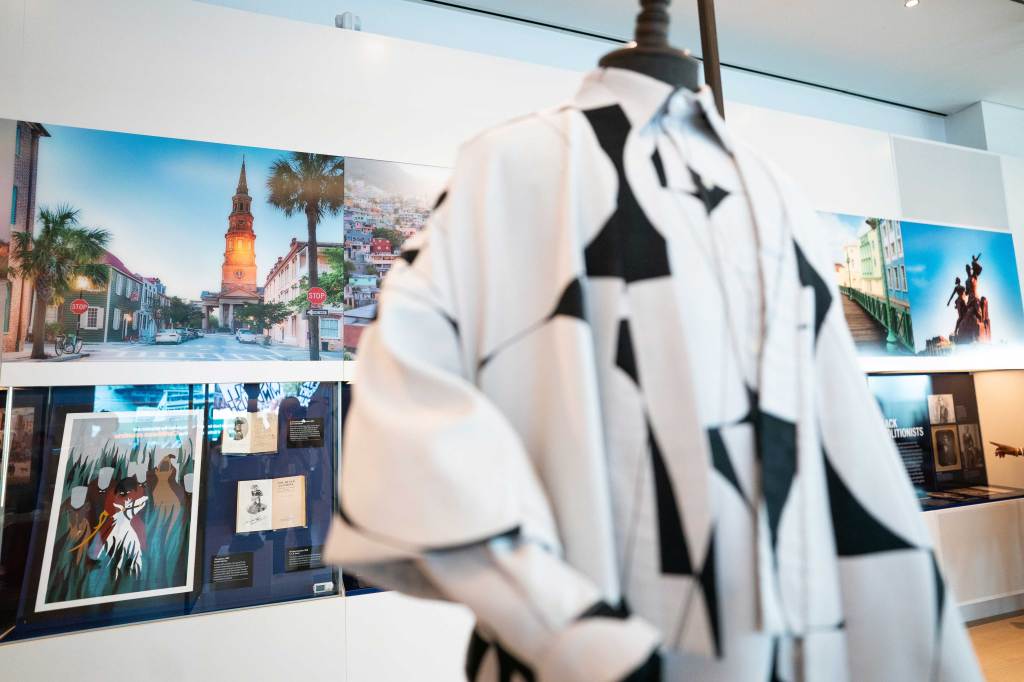 Getty
GettyThe Venice Biennale is one of the most significant exhibitions in the contemporary art world: a revered showcase of international artists representing their home countries and vying for glory. Founded in 1895, it is one of art’s oldest and most celebrated stages, drawing hundreds of thousands of visitors. And this April, when the 60th annual Biennale opens, it will make history anew: The United States’ pavilion will feature the multimedia artist Jeffrey Gibson, making him the first Indigenous artist to represent the U.S. with a solo show.
Gibson has long been a star in the art world for his vibrant multimedia works, which repurpose materials such as vinyl and beads, incorporate pop music lyrics, and more. The New York resident is a member of the Mississippi Band of Choctaw Indians and is of Cherokee descent. (His work, and the Venice Biennale, are supported by Ford.) His exhibit will mark the first time an Indigenous artist has appeared in the Biennale’s U.S. pavilion since 1932, when it included a group exhibition on themes of the American West.
Gibson’s showcase is an exciting moment, but it also reminds us of the art industry’s historic lack of diversity and inclusion for artists who are Black, Indigenous, and people of color (BIPOC). In 1992, a proposed tour of the Whitney Museum of American Art’s Jean-Michel Basquiat retrospective was canceled when no other museums showed interest. A 2019 survey revealed that nearly 85% of artists represented in U.S. museum collections are white. And today, the Mellon Foundation’s Museum Demographic Survey shows that less than 20% of art museum leadership positions are held by people of color.
The art world is slowly changing to reflect the immense talents of artists from all communities and backgrounds. The Biennale’s U.S. Pavilion is co-commissioned by Kathleen Ash Milby, a member of the Navajo Nation and a curator of Native American Art at the Portland Museum, a Ford grantee. The Whitney’s 2022 exhibition no existe un mundo poshuracán: Puerto Rican Art in the Wake of Hurricane Maria was a crucial exhibition on the state of contemporary art and of the island. This spring, the Metropolitan Museum of Art in New York will debut The Harlem Renaissance and Transatlantic Modernism, an exhibit that explores the Harlem Renaissance as the first African-American-led movement in international modern art (and is supported by Ford).
Many of our grantees are also leading this cultural shift. The International African American Museum (IAAM) in Charleston, South Carolina, centers the art and narratives of Black artists, including a current exhibition from the multimedia artist Ming Smith. The Museum of Contemporary Art Detroit (MOCAD) celebrates the art of Michigan’s 12 federally-recognized Indian nations and Indigenous communities. The BIPOC Arts Network and Fund (BANF) in Houston supports and elevates artists of color across the city, including those from Black, Latinx, Indigenous, Asian American, Pacific Islander, and Middle Eastern communities.
We spoke to leaders of these three groundbreaking organizations about how they are working to create a more equitable future for art.
Malika Pryor, Chief learning and engagement officer, International African American Museum (IAAM)
Tell us about your organization’s mission and one current project you’re really excited about.
The idea for the IAAM began 23 years ago to honor untold African American stories at one of the United States’ most sacred grounds. Because we are located on what was once Gadsden’s Wharf, we’re compelled to think about the transatlantic slave trade and the millions of people brought to a place they never agreed to be. I’m really excited about our North Star exhibition, which will debut this May and is our first internally produced traveling exhibition. Our hope is that it will be a moving microcosm of the museum, with everything from artifacts to technology to visual and literary arts creating a conversation. It will be a wonderful way to experience history and culture.
Paul Robeson once said, “Artists are the gatekeepers of truth. We are civilization’s radical voice.” Do you agree with this?
Man, Paul Robeson. What a giant! For people of African descent—whether you’re Jamaican, Afro-Brazilian, Ghanaian, or Nigerian—there’s a shared Pan-African experience of the inanimate being animated through ritual and life. Beauty doesn’t just stand on its own. It is a communication of cultural memory, spiritual belief, transformation, family, legacy, love, and resistance. Art exists because human beings create, and in many instances, it is the way that we can vocalize the ideas that are difficult to say out loud.
Why is philanthropic investment in diversity in the arts critical to building equality and ensuring that history does not repeat itself?
Memory is a gift. Arts and cultural institutions are our collective archive. They determine what we remember. If we do not commit to telling diverse stories, we commit ourselves to the loss of memory. And if we cannot recall something in our collective cultural memory, we doom ourselves to relive it. We can never tell all the stories, but if there’s only one voice and one version of events, there is only one truth. People need to be able to share multiple truths. Our existence depends on it.
This National Black History Month theme celebrates African Americans in the arts. Which Black artists or creative organizations are catalyzing important change today?
We have a core, chronological exhibition that is about the people who aren’t written about in textbooks. I’m thinking about the grandmothers and aunties who baked and sold cakes so the Montgomery bus boycotters could pay for gas and form carpools. We’ll never know all their names, but I’m proud our museum is thinking about these women and others who were behind the scenes making history. I’m also a huge fan of the Schomburg Center and the California African American Museum. I’m excited about the Johnson Collection and the work the Getty is doing with its African American Art History initiative. The Charles H. Wright Museum has a really beautiful exhibit right now featuring the work of the fabulous costume designer Ruth E. Carter.
Sixto Wagan, Program director, BIPOC Arts Network and Fund (BANF)
Tell us about your organization’s mission and one current project you’re really excited about.
As a new organization, the BIPOC Arts Network and Fund works in the greater Houston area to bring together philanthropy, artists, and community leaders. We’re both a resource network and a place where people can learn from BIPOC arts communities. A lot of the work is about connecting and sharing knowledge.
Houston recently completed the process of nominating its Cultural Treasures. In 2023, applicants went through a process and we named 11 groups as anchor organizations for communities of color. Our first cohort will come together to dream, connect, and create. Underfunding has forced so many of our leaders to work in a state of constant crisis. They’re craving an opportunity to vision together.
Paul Robeson once said, “Artists are the gatekeepers of truth. We are civilization’s radical voice.” Do you agree with this?
Truth is a radical concept, particularly in a state like Texas, where schools are being told that they cannot teach the histories of our communities of color. Artists and arts organizations hold the truth and share it. They’re also creating opportunities to experience the truth in ways that are comforting, healing, and challenging. Part of our work is to uplift all of Houston’s diversity so that all our residents can experience that truth.
Why is philanthropic investment in diversity in the arts critical to building equality and ensuring that history does not repeat itself?
Philanthropy must be an advocate for communities of color everywhere. This is especially important in places where diversity and the lived experiences of our people of color are regularly challenged. So many major arts institutions have just begun to shift from focusing exclusively on white western history to lifting up the voices of Black, Latinx, and Asian communities. Some of that positive change is because of philanthropic leadership.
This National Black History Month theme celebrates African Americans in the arts. Which Black artists or creative organizations are catalyzing important change today?
The S.H.A.P.E. Community Center is one of our Houston Cultural Treasures. They just celebrated their 55th anniversary and they’re finally being recognized for celebrating Black history and highlighting its richness.
Jova Lynne and Marie Patton, Co-directors, Museum of Contemporary Art Detroit (MOCAD)
Tell us about your organization’s mission and one current project you’re really excited about.
MOCAD believes that art has the transformative power to inspire change and shape our collective future. We try to educate all our visitors, whether they are nine or 99, and show them that art is a tool for understanding the world. Our upcoming spring/summer program celebrates the richness and diversity of Black cultural phenomena. We’re looking forward to showing Meleko Mokgosi, who examines how systems of power play out in the Pan-African context, and Lakela Brown, who explores nourishment practices across Black communities.
Paul Robeson once said, “Artists are the gatekeepers of truth. We are civilization’s radical voice.” Do you agree with this?
Art has always been a way for people to understand each other. In Detroit, the arts are integral to how our city envisions a more just world. Artists must be truth-tellers. Their stories document how our communities are living through a pandemic, economic crisis, radical white supremacy, and imperialism.
Why is philanthropic investment in diversity in the arts critical to building equality and ensuring that history does not repeat itself?
Systemic barriers—racism, sexism, ableism, and economic inequality—have long kept BIPOC communities from opportunities in the arts. Philanthropy can help end that. When foundations invest in us, we can create the kind of museum that truly echoes the cultural lexicons of our communities. We can become a place of real knowledge sharing and serve as a model for future generations of museums.
This National Black History Month theme celebrates African Americans in the arts. Which Black artists or creative organizations are catalyzing important change today?
We’re encouraging folks to learn more about the Black Bottom Archives. They’re a community-driven media platform that amplifies the voices, experiences, and perspectives of Black Detroiters using storytelling, journalism, art, and community organizing. Their work shows how history, storytelling, and community are crucial to our collective liberation.
